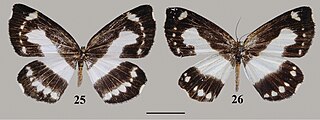
Carnivora is an order of placental mammals that have specialized in primarily eating flesh, whose members are formally referred to as carnivorans. The order Carnivora is the fifth largest order of mammals, comprising at least 279 species on every major landmass and in a variety of habitats, ranging from the cold polar regions of Earth to the hyper-arid region of the Sahara Desert and the open seas. These mammals have a large array of diverse body plans with a wide diversity of shapes and sizes.
Chemical thermodynamics is the study of the interrelation of heat and work with chemical reactions or with physical changes of state within the confines of the laws of thermodynamics. Chemical thermodynamics involves not only laboratory measurements of various thermodynamic properties, but also the application of mathematical methods to the study of chemical questions and the spontaneity of processes.
Panthera is a genus within the family Felidae, and one of two extant genera in the subfamily Pantherinae. It contains the largest living members of the cat family. There are five living species: the jaguar, leopard, lion, snow leopard and tiger, as well as a number of extinct species.

A mongoose is a small terrestrial carnivorous mammal belonging to the family Herpestidae. This family is currently split into two subfamilies, the Herpestinae and the Mungotinae. The Herpestinae comprises 23 living species that are native to southern Europe, Africa and Asia, whereas the Mungotinae comprises 11 species native to Africa. The Herpestidae originated about 21.8 ± 3.6 million years ago in the Early Miocene and genetically diverged into two main genetic lineages between 19.1 and 18.5 ± 3.5 million years ago.

Sarcophagidae are a family of flies commonly known as flesh flies. They differ from most flies in that they are ovoviviparous, opportunistically depositing hatched or hatching maggots instead of eggs on carrion, dung, decaying material, or open wounds of mammals, hence their common name. Some flesh fly larvae are internal parasites of other insects such as Orthoptera, and some, in particular the Miltogramminae, are kleptoparasites of solitary Hymenoptera. The adults mostly feed on fluids from animal bodies, nectar, sweet foods, fluids from animal waste and other organic substances. Juveniles need protein to develop and may be laid on carrion, dung or sweet plant foods.

Epicopeiidae is a family of insects in the order Lepidoptera. They are known as oriental swallowtail moths as they closely resemble some oriental swallowtail butterflies. Epicopeiidae have highly varied structure in regards to body size and wing shape. Epicopeiidaen wing patterns are involved in complicated mimicry rings.
Balaca is a monotypic moth genus in the subfamily Arctiinae. Its only species, Balaca picaria, can be found in New Guinea. Both the genus and the species were first described by Francis Walker in 1865.

Nine holes is a two-player abstract strategy game from different parts of the world and is centuries old. It was very popular in England. It is related to tic-tac-toe, but even more related to three men's morris, achi, tant fant, shisima, picaria, and dara, because pieces are moved on the board to create the 3 in a row. It is an alignment game.

Tant fant is a two-player abstract strategy game from India. It is related to tic-tac-toe, but more closely related to three men's morris, nine holes, achi, shisima, and dara, because pieces are moved on the board to create the 3 in a row. It is an alignment game.

Picaria is a two-player abstract strategy game from the Zuni Native American Indians or the Pueblo Indians of the American Southwest. It is related to tic-tac-toe, but more related to three men's morris, Nine Holes, Achi, Tant Fant, and Shisima, because pieces can be moved to create the three-in-a-row. Picaria is an alignment game.

Arichanna is a genus of moths in the family Geometridae.

Hyposidra is a genus of moths in the family Geometridae first described by Achille Guenée in 1857.
Polypoetes is a genus of moths of the family Notodontidae. It consists of the following species:

Hyposidra picaria is a geometer moth in the Ennominae subfamily first described by Francis Walker in 1866. It is found throughout Sundaland.
Abraxas picaria is a species of moth belonging to the family Geometridae. It was described by Frederic Moore in 1868. It is known from Bengal.
Elachyophtalma is a genus of moths of the family Bombycidae. The genus was erected by Cajetan Felder in 1861.
Polypoetes picaria is a moth of the family Notodontidae. It is endemic to eastern Peru and northern Bolivia at an altitude of approximately 3,000 meters.

Psychostrophia is a genus of moths in the family Epicopeiidae. The genus was erected by Arthur Gardiner Butler in 1877.
Termanu is a Central Malayo-Polynesian language of Roti Island, off Timor, Indonesia. Speakers of Korbafo and Bokai dialects are ethnically distinct.

Psychostrophia endoi is a moth in the family Epicopeiidae. It was described by Hiroshi Inoue in 1992. It is found in Laos.










